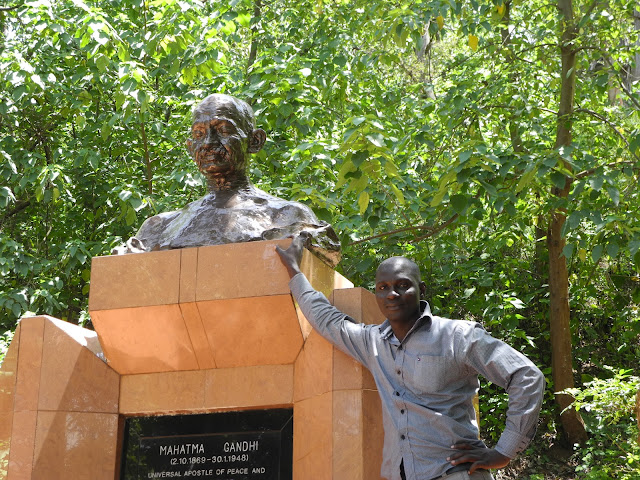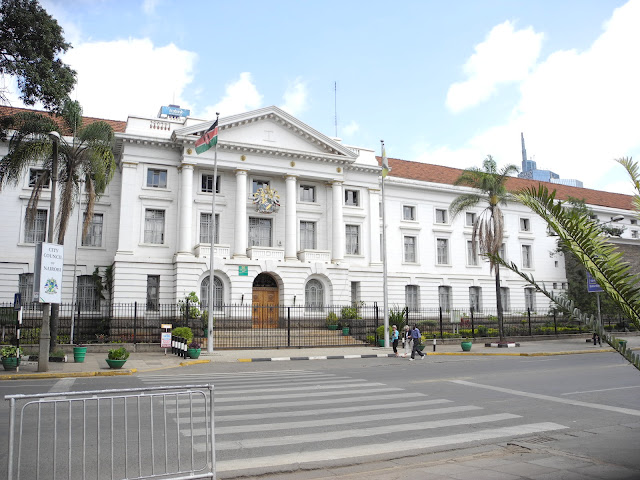Kampala is a lovely city. I regret I did not have time to take any photos that showed the breathtaking sight of the city below from the hills above . I really enjoyed Kampala and found the people among the most pleasant and cultured of my African journeys.
It has nice shopping centers with good restaurants. My favorite was Ranchers which is a chain, featuring a combination butcher shop and grill.
The shopping center had many such statues in its parking lots.
I am not sure how effective that warning side actually is.
This area is
on the edge of the city, the start of the suburbs. My driver said Idi Amin
built "white " apartments and "brown apartments", nothing to do with race, just the
color of the buildings, to help the poor and middle class. He was able to so
with the help of the Israelis who actually did the construction. The driver
said the first two years of Amin's rule gave no hint of the horror to follow (1971-
1979).
Amin's rule was characterized by human rights abuse, political repression, ethnic persecution, extrajudicial killings, nepotism, corruption, and gross economic mismanagement. The number of people killed as a result of his regime is estimated by international observers and human rights groups to range from 100,000 to 500,000.(Wikipedia)
He fled the country when he lost a war with Tanzania brought on by his trying to annex part of that country.
Local site on my journey to the martyrs shrine and to the source of the Nile.
Namugongo - Martyrs Shrine
On 3 June 1886, thirty-two young men, pages of the court of King Mwanga II of Buganda, were burned to death at Namugongo for their refusal to renounce Christianity. Some of the men were of the Anglican faith and others wee of the Catholic faith. They were rolled into individual mats, stacked atop each other and burned. Supposedly, they sang hymns until the very end.
.
Twenty two of the Catholic Martyrs were canonized by Pope Paul VI on October 18, 1964 and are regarded as saints in the Catholic Church. (What happened to the other ten?)
A basilica has been built at the spot where the majority of them were burned to death. A church stands at the place where the Anglican martyrs met their death, about 2 miles (3.2 km) further east from the Catholic Basilica.
This is a manmade lake down from the church. You can see benches in the photo and they go all around the lake. Annually, on June 03, Christians from all parts of Uganda, East Africa and other parts of the world congregate at Namugongo to commemorate the lives of the Uganda Martyrs and their dedication to their religious beliefs. Crowds have been estimated in hundreds of thousands in some years
I knew of the 3 great pilgrimages of the West: pilgrimage to Jerusalem, pilgrimage to Rome and the pilgrimage to St. James tomb in Spain.
I learned that people from Kenya and Sudan walk hundreds of miles from their own countries in order to reach the shrine by June 3.
The main reason for my journey was to stand at the source of the Nile. I had read the stories of the great explorers who searched for the source of the Nile: Gordon, Livingston, Stanley, Burton and Spekes. They were a hardy lot. Dr. Livingston lost the use of his left arm in a lion attack. Richard Burton was speared in the head in an attack on his camp site. Their journeys were followed by the press in every country. In fact, the editor of the New York Herald paid Stanley to "find" Livingston on his search for the source of the Nile. His stories more than paid for his trip, enriched the Herald and made him (Stanley) famous ("Dr. Livingston, I presume" upon finally meeting him)
For centuries, the source of the mighty River Nile
was shrouded in mystery in the dark heart of Africa. In Roman times, the phrase
caput Nili quærere, “to search for
the head of the Nile”,was used as a metaphor for any foolish or impossible
endeavor, and many explorers tried and failed. (Wiki)
The Nile is an "international" river as its water resources are shared by ten countries Tanzania, Uganda, Rwanda, Burundi, Democratic Republic of the Congo, Kenya, Ethiopia, Eritrea, South Sudan, and the Arab Republic of Egypt (Wiki)
The Nile is an "international" river as its water resources are shared by ten countries Tanzania, Uganda, Rwanda, Burundi, Democratic Republic of the Congo, Kenya, Ethiopia, Eritrea, South Sudan, and the Arab Republic of Egypt (Wiki)
Here I am standing at the source of the Nile or what many in the late 1800s believed was the true source.
The source of the Nile was considered to be Lake Victoria, (right behind where I am standing) but the lake has feeder rivers of considerable size, complicating the question of the true source ofthe Nile.
Scientists today believe the Nile starts in Rawanda but in an area of inaccessible jungle.
Lake Victoria was first sighted by Europeans in 1858 when the British explorer John Hanning Speke reached its southern shore while traveling with Richard Francis Burton to explore central Africa and locate the great lakes. Believing he had found the source of the Nile on seeing this "vast expanse of open water" for the first time, Speke named the lake after the then Queen of the United Kingdom
Supposedly the little island holds an underground spring that, combined with Lake Victoria behind it, is the source of the Nile .
Henry Morton Stanley who confirmed Speke's discovery, circumnavigated Lake Victoria and reported the great outflow at Ripon Falls on the Lake's northern shore. Spekes and Stanley spoke of the majesty of Ripon Falls and was sure the Nile started here. Today these steel girders mark the spot where the falls used to be! A dam was built up river that completely flooded the area and encompassed the falls.
Is nothing permanent?
This monument to Ghandi marks the spot where he wanted his ashes to be strewn.
As the monument states , he wanted his last act to be one that continued his quest for peace.
My guide and driver, Moses, to me, is a great man in his own right. Moses is one of the most impressive people I have met in all my journeys. He is a former hotelier who decided to start his own guide / driver business. He is soft spoken, respectful to all, almost saintly.
He told me he had eleven children, ranging in age from five to eighteen... Four were his biological kids and seven were nephew and nieces whose parents had died of AIDS. He said in the 90’s the AID disease was still little understood and it was only with better education and better medicine the disease was arrested. The education was in the form of “A-B-C “: abstinence, being faithful, using condoms.
He told a chilling story that the kids whose parents died of AIDs in the 90’s are now having babies of their own. Some are free of AIDS, like his kids; some don’t know they have the disease; some think the medicine that arrests the disease cures the disease. The number of people now affected has climbed recently from 6 to 8 % of the population, according to Moses
On our way back, Moses asked if we could stop at the boarding school where two of his kids study and are now seniors.
Here he is with his two kids: Morris and Rhoda. Parents can only visit their childen the last Sunday of the month. How sad.
His daughter calls the school “the prison”. It probably feels like that : she must study until 11 pm every night and then get up at 4 a.m. to start the day.
WebRep
currentVote
noRating
noWeight



















































